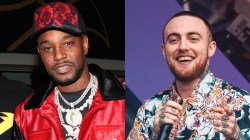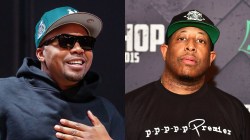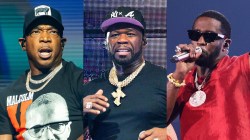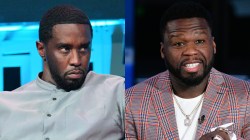Hip Hop heads cried foul when Billboard placed Kendrick Lamar in its top 10 MCs of all time, but the music speaks for itself. The Compton-bred superstar is in the midst of one of the best album runs that rap has ever seen. And he’s still getting his 30 under 30 on. Since his independent album Section.80, he has proven his spot as rap’s golden child in every quantifiable measure. As he garners praise from peers, predecessors and fans alike, he leads copycats in one direction before completely leaving them behind within a year or two later. And the music is transcending headphones and show stages, with “Alright” becoming a rallying cry for protesters fighting against police brutality. It’s not getting caught up in the moment, it’s the truth: Kendrick Lamar is one of the greatest to ever pick up a microphone, and we’re witnessing it in real time.
To celebrate the one-year anniversary of his DX-perfect masterpiece, To Pimp a Butterfly, read below to see how K. Dot is cementing his legacy, one cinder block at a time.

The Kendrick Lamar EP (2009)
Brilliance without the fanfare is still brilliance. That said, Kendrick didn’t necessarily eclipse the sun on his debut like several rap legends molded in the 90s. The project that birthed Kendrick Lamar sticking with his government name for professional usage showcased a very raw talent; almost demo-like if one were to hop in a Delorean and analyze his future work. Top Dawg Entertainment has maintained a buzz in the streets for some time now but at the time of the self-titled release, all eyes were on Jay Rock, who appears on the street savvy “I Do This,” an early bud of “Money Trees.” In fact, when Rapper Big Pooh invited the 90059 resident to the studio for his Delightful Bars album, Rock showed up with his then relatively unknown Black Hippy members and Kendrick earned himself a reliable connect to turn into a guest feature.
Day one fans will forever point out that Kendrick has never been a conventional rapper made to narrate over conventional production. Kendrick Lamar EP’s score is riddled with jazzy arrangements layered with one-two drum patterns intended to keep the head nod consistent. Albeit a far cry from the free-flowing instrumentation that had him clutching golden gramophones on a tranquil February evening, the beats served as a precursor for the unassuming greatness that was around the corner.
O(verly) D(edicated) (2010)
When I first heard O(verly) D(edicated)’s intro “The Heart Pt. 2,”, I was impressed but not blown away enough for him to take up room in my iPod. But upon giving the album a chance years later, it’s clear why it garnered so much attention, even if it’s missing what makes him so great.
Kendrick shows stunning technical ability on O(verly) D(edicated) with the laundry list of what makes a good MC: precise flows, memorable lines, and a good mix of concept songs and imagery. Themes that would come up on later projects—vices of alcohol and sex (P&P 1.5), infidelity (Opposites Attract (Tomorrow W/O Her))—appear here, and he brought a level of thoughtfulness that made him stand out from the pack. “Ignorance is Bliss” was reportedly the song that caught Dr. Dre’s attention, and it’s clear to see why, with Kendrick’s deft mix of street and conscious with plot twists to end his verses.

O.D. is a quality mixtape that rightfully showed his potential, but it’s missing what has made him a legend: humanity and purpose. Kendrick rips mics and gives occasional food for thought, and he could definitely come up with interesting concepts. But for all the great imagery he paints, there aren’t any lives attached to the music yet. Instead of testimonials, they feel like writing exercises from a prodigy still developing his talents. Good thing, though: his pen game would came in handy after adding the other tools to his arsenal.
Section.80 (2011)
For just about every rapper I’m a fan of, I can pinpoint the song, verse or album that made me take him or her seriously. For Freddie Gibbs, it was the Miseducation of Freddie Gibbs; for Big Sean, it was “Supa Dupa;” for Drake, it was the Comeback Season intro, “The Presentation.” Once a friend let me hear “Ronald Reagan Era,” I knew I would be a Kendrick Lamar fan.
Kendrick looked to literally represent a generation with Section.80, telling the story of 80s babies who grew up in poverty. Addictions to sex, violence and drugs all play roles here, and Kendrick excelled by putting equal attention to detail into both macro and micro lenses. “No Makeup (Her Vice)” and “Keisha’s Song (Her Pain)” tell the tragic story of a slain prostitute, and “ADHD” speaks about his generation’s dependence on controlled substances to cope with their depression. While he occasionally speaks about his own experiences, he rarely focuses on himself for too long. As he says on “Poe Man’s Dreams,” “but anyway, this for my niggas.” The relatively selfless approach was a powerful one. It made him stand out in a genre that is often inherently narcissistic, and it built rapport with his listeners to trust him as a spokesperson who would represent them with candor, sympathy and compassion once he got a shot at mainstream exposure. In the subsequent years when Kendrick Lamar would turn inward to tell his own story and take his position as a leader, he had already laid a foundation that showed an acute understanding of the world that he and his listeners inhabited.

Along with its powerful lyrical messages, Section.80 also served as a prelude to the rich black musical pallette of To Pimp a Butterfly and untitled unmastered. “Rigamortus” showcased an appreciation of jazz with its medley of horns and Kendrick’s percussive, quick-tongued flow. “Ab-Soul’s Outro” perhaps sets the tone for TPAB most accurately. Along with Kendrick’s TDE compatriot stunningly summarizing Section.80’s testimonies, Kendrick takes a stab into spoken word poetry, while a saxophone solo by Terrance Martin and live drums and cymbals serve as the backdrop.
good kid, m.A.A.d city (2012)
With the success of Section.80 and the accompanying road dates with his TDE counterparts on a BET Music Matters tour, the hype for good kid, m.A.A.d. City had reached a fever pitch before its October 2012 release. The album ended up fulfilling its hype in spades—Kendrick showed that the trust he earned from fans was well-deserved.
While Section.80 succeeded by humanizing the lives of his generation as a whole, Kendrick’s major label debut introduced fans to his hometown of Compton and told his own coming-of-age story that showed his place in those two worlds. While “Kush & Corinthians” showcased the concept of struggling between good and evil, GKMC’s “The Art of Peer Pressure” and “m.A.A.d city” conveyed Kendrick’s own battles to do the right thing, as he begrudgingly breaks into a house and sets up robberies at his workplace. Section.80’s “ADHD” describe substance abuse of Kendrick’s peers, while “Swimming Pools” and the final verse of “good kid” show that he has dealt with his own alcoholism and drug use as well. The humanism is elevated another notch, because Kendrick is able to describe his emotions just as clearly as he can narrate a story. And as before, outside characters have their own places. Skits and song titles give these characters names, personalities and storylines, but the most notable example is the poignant “Sing About Me,” which features vignettes of two people speaking to Kendrick. One of them is a gangbanger mourning his brother who was killed on the preceding skit, thanking Kendrick for loving him, and lamenting the hopelessness that he will suffer his brother’s same fate. The other is the sister of Keisha, the prostitute stabbed to death on Section.80, resenting Kendrick for telling her story. Both suffer tragic deaths on the song, leaving Kendrick to think them over.

By the time Kendrick embraces Christianity as a way out on “I’m Dying of Thirst,” preaches his new philosophy on “Real” on and emerges with Dr. Dre on the triumphant closer “Compton,” the listener feels relieved that his story ended with redemption-he suffered the same demons as the people he depicted so well.
In retrospect, good kid, m.A.A.d city played by the rules while breaking them at the same time. Kendrick breathed new life to the concept album, inspiring other MCs to take a similar approach and step up their own efforts with creative narratives. His varying vocal inflections and unconventional song structures would be lifted by youngsters following his footsteps. But he also knew how to play the game, just on his own terms. The album is good production-wise, but it doesn’t reinvent the wheel. “Bitch Don’t Kill My Vibe,” “Swimming Pools” and “Poetic Justice” were all custom K. Dot spins on radio formats that had already been successful. His willingness to speak to fans on their own terms was smart: with his followup, To Pimp a Butterfly, that trust would become invaluable.
To Pimp A Butterfly (2015)
There isn’t much that hasn’t been said about To Pimp a Butterfly; it appeared on 101 year-end album lists and topped 51 of them, while gaining just as much praise from his contemporaries. But for me, the album’s prevailing emotion is its uncertainty. Section.80 and good kid each concluded with empowerment: “HiiiPower” encourages listeners to buck the system and create the lives they want with “their own pyramids and hieroglyphs,” and “Compton” served as the storybook ending of Kendrick’s struggle through poverty and violence. But To Pimp a Butterfly’s wouldbe happy ending, a live version of the Grammy-winning “i,” is interrupted with a fight in the audience and a lecture from Kendrick. After the sobering “Mortal Man” concludes with Kendrick talking to an unresponsive ghost of Tupac Shakur, our griot leaves with just as many questions as he does answers. He’s tackling the possibility that there may not be a happy ending, after all–for his community, or for himself.
I have questions just like Kendrick does. In 2010, I worked as a counselor at a placement facility for children who had committed crimes. As staff, we supervised these kids–anywhere from age 10 to 16–and helped counsel them to prepare them to reenter the society on the right track. Some of them were, as Kendrick said, “Institutionalized”–so deeply entrenched in culture from prison, their neighborhoods and their families that such negativity was the only concept that was tangible to them. One kid left our facility, and was arrested as part of a robbery and homicide with his father. Another was killed at age 18, years after leaving our care. I cried for these kids like they were my own, similar to the grief that Kendrick expressed on Butterfly.
The album also reflects the police brutality being captured by TV and social media after ravaging black people for years. The rage on “The Blacker the Berry” reflects the anger I had the night I got an iPhone notification that George Zimmerman was found not guilty, when I left the group of friends I was with at a festival to silently mourn in my workplace’s office while watching TV reports. The song captured the fear I had during a police encounter in college, when four cop cars surrounded me with suspicion of me stealing my own vehicle. It comes to mind when I see the Voting Rights Act repealed by the Supreme Court, or when I see white musicians raking in dollars and awards while appropriating black art. It comes to mind when black artists are only respected when conveying or feigning humility, as Pharrell did during an acceptance speech at the Grammy Awards days before “The Blacker the Berry” was released on YouTube. But the joys of TPAB are just as much a part of my reality: “Alright” provides hope in spite of the despair, while “You Ain’t Gotta Lie” and “Complexion (A Zulu Love)” illustrate the self-love and camaraderie that keep me going.
Musically and aesthetically, Butterfly takes a hard left from the digestibility of GKMC. The industry-ready production and song structures from before were almost completely shut out, in favor of a new amalgamation of funk, soul and jazz that was concocted by Terrace Martin, Robert Glasper and Thundercat. The inventive rhymes and stylings were pushed even further, with Kendrick using scat, spoken word poetry, and sing-songy flows just as much as his conventional rapping. Critics gushed and fans were blown away, but the album was surely challenging and overwhelming for others. For some, Kendrick’s musical detour was respected, but it was too much to handle.

Kendrick struggled with the issue himself on “u” and “Mortal Man:” how much of a leader are you if the people who matter most can’t keep up? Four years earlier, on “HiiiPower,” Malcolm X and Martin Luther King Jr. were motivation to do his best and embrace his place as a leader. Now, those same leaders are a constant reminder of an unreachable standard and a seemingly unavoidable fate. And while outsiders are praising him for his depiction of his generation, the people Kendrick is working so hard to uplift are either too busy living their realities or are so far removed from his resources that he can’t reach them. How can Kendrick capture the humanity of his community in a way that empowers them, helps outsiders understand, and maintain his own sanity, at the same time? Activists and organizers in this new era of civil rights are asking themselves the same question every day. But To Pimp A Butterfly shows that the willingness and bravery of tackling that question head-on is most important.
untitled unmastered. (2016)
While Kendrick Lamar was building his legacy as an album architect over the past four years, he was also establishing himself as a performer with seemingly timeless performances at award shows and on late-night TV. Kendrick and his band used appearances on The Colbert Report, The Tonight Show Starring Jimmy Fallon, and the Grammys as platforms to showcase unreleased songs, claiming that they would never see the light of day. But after every performance, fans begged for Kendrick to release the songs-and apparently, a plea from LeBron James convinced Top Dawg to release untitled unmastered., a collection of records from the TPAB sessions, as a surprise in March. The result is another critic-proof offering from Kendrick Lamar: part jam session, part keyhole glimpse into the maverick’s creative process.
The project is something his fans aren’t used to. While Kendrick’s previous albums are marked by their thoughtfulness and meticulous attention to detail, untitled unmastered. is blatantly incomplete. This time, it’s more about enjoying a bonus collection of B-sides that didn’t make the cut. And even though the songs aren’t album-ready, they definitely aren’t throwaways: Kendrick and his collaborators’ half-baked ideas are more interesting than the best efforts from some of his contemporaries. Kendrick paints apocalyptic images and pleads for God’s salvation on “untitled 01 | 08.19.2014,” and he trades rhymes with Jay Rock and Punch about inequality for minorities over beautiful live instrumentation on “untitled 05 | 09.21.2014.” CeeLo even pops up on “untitled 06 | 06.30.2014,” conjuring curiosity about who else came through those sessions to participate. At this stage in his career, it almost comes as no surprise the album went No. 1 on the Billboard 200.

But with all the creative genius brewing here, perhaps the most gratifying part of untitled unmastered. is just hearing Kendrick bask in his moment. With all the stress he reveals on To Pimp a Butterfly, one hopes that he can at least have a good time while creating the music run as one of rap’s greats.




![Method Man Admits He Didn't Like Drake's "Wu-Tang Forever": "I [Wasn't] Getting On That"](https://hiphopdx.com/wp-content/uploads/2025/12/method-man-drake-wu-tang-forever-remix.jpg?w=250)






agree… tpab alone is one of the best albums I have eever heard
I agree Kendrick is on an impressive run. The thing that most impresses me is that his albums are completely different, yet compeltely amazing
Kendrick brought us through the streets in GKMC, but TPAB does something even more impressive…With strong influences of soul, bebop jazz, r&b, p-funk, and all sub-categories of hip-hop, Kendrick has essentially made an amalgam of the beautiful art to be created throughout African-American history. It is a love letter to Black Culture and where it is today.
One of the greatest ever
Prince was right, the musical composition of tpab is one of the best ever in music history
when your mom was gagging on his cawk….tru story
Lol when did Prince say that?
Budden was right, nobody is ever gonna top gkmc/tpab
highly medical marijuana strain and pain killer pills including vaporizer gasses and pure nicotine available at lower prices.you can get to us at ricklawson363@gmail.com or via 9295007057
Section 80> everything else
tpab > gkmc > s80
first 2 are classic, the last one is amazing
I wonder if tpab wil lever be topped, this is easily a top 5 albm of all time in any genre
Hmm..I would say top 20. Have u heard The Wall?
Dude already sitting on 2 classics (with tpab being his magnum opus)
I respect the shit out of TPAB. I truly think it will go down as one of the best albums ever. But for me, his other albums that come before it are more listenable and can be played more often. And that’s something that I personally look for in an album. In no way am I saying that those albums are better, just preference.
Best article for king kendrick one of the best our generation got
Hip Hop Lives. Thanks Kendrick!
Tpab might be one of the best albums of all time in music history
musically, this is up there with the absolute best musicians
Musically, kendrick is never gonna top tpab, but then again like Prince said, its better than anything else released these last 20 years.
Kendrick was about to be one of the best, but with tpab, he cemented his position as one of the best ARTISTS OF ALL TIEM, dude is more than just a rapper now
Gkmc is the only kdot album I don’t like, but I can be objective enough to admit it will go down as his second album after gkmc
Yeah, he had a great catalog before tpab, now he has the perfect catalog
Kendrick Lamar EP is extremely underrated
For me Section 80 and TPAB are the defining albums of black music for the post 2010 generation of young music fans. The dude just about floated on those, esp considering the glossier albums that were released in their times. 2011( Watch the Throne, Take Care, Carter IV, Coleworld etc.) 2015 (If you’re reading, Dark Sky Paradise, Album About Nothing etc.) …. Dot is such a formiddable artist bro. Can’t wait to see where he’ll take the next shit…. Do something we wont expect again……
What bout his gangster rap phase tho? Before the whole jazz epiphany
legendary catalog
we need tpab 2 fam
truth
really starting to fall in love with tpab’s musical composition… I now understand why its getting all that praise
Kendrick about to join kast, face & GH tbh
Kendrick really is in his own league musically
REALLY well-written review. I’m now inspired to check for Kendrick in a way I hadn’t been previously. Thank you for writing. Good stuff!
Only other people I can remember putting out four straight undisputed classics was Public Enemy or OutKast